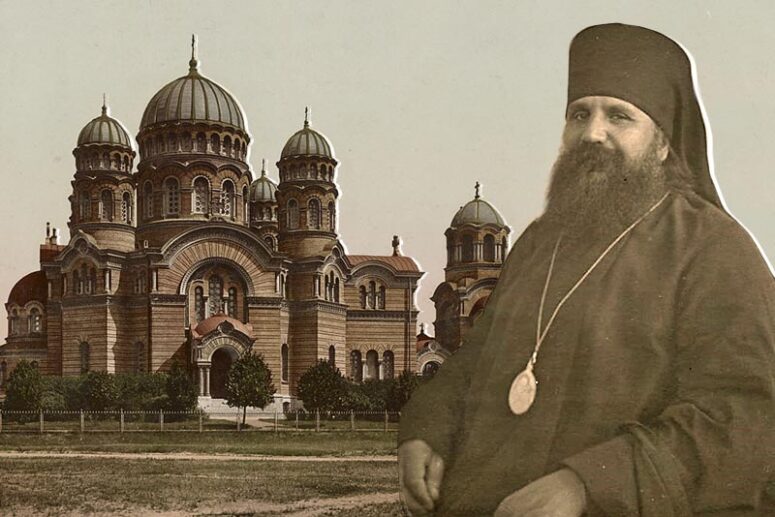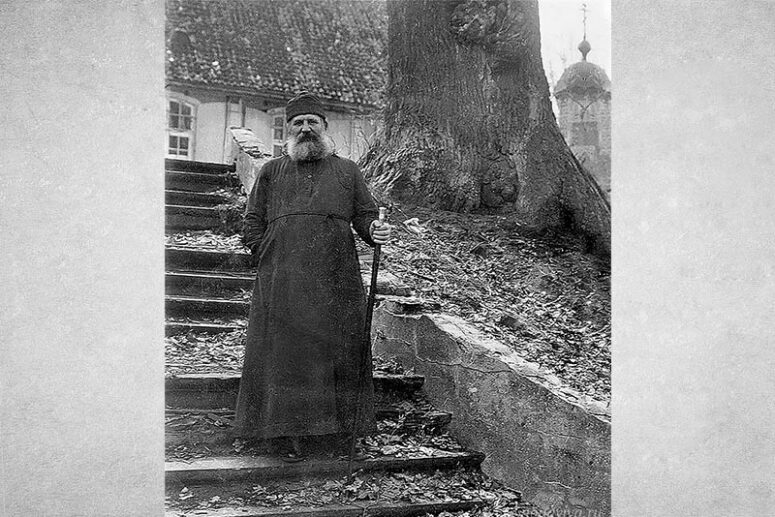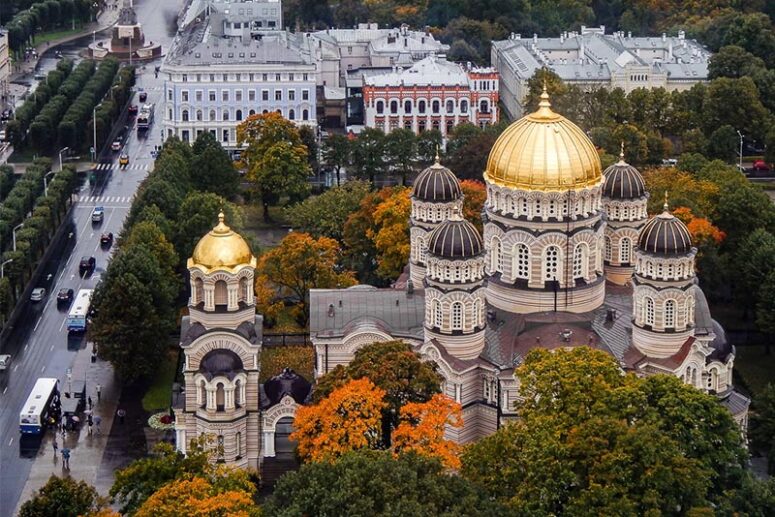
“We would not endure and die of love for every person,
if we saw them as they were in Christ.”
Hieromartyr John is commemorated on the 12th of October
Poor little boy Janis
As a child, Janis had a humble duty of herding sheep. Throughout his life, he held on to the precious memories of gathering with his family to pray. Each day commenced with their presence in the same room, where his father would read a chapter from the New Testament. Following that, the children would join in reading aloud and singing prayers.
Janis possessed robust health and an enduring spirit. He often found solace in daydreaming and contemplation. Notably, his ability to learn quickly stood out. At the tender age of nine, despite hailing from a modest family that couldn’t afford primary school, he secured a place in a secondary school. His teachers quickly recognized his talents, and it was a local priest who suggested he enter the seminary.
A Man of Iron Will

In the year 1900, John Pommers, a 24-year-old alumnus of the Riga Theological Seminary, received acceptance into the prestigious Kiev Theological Academy. It was there that he felt the calling to become a monk. He took it upon himself to write a heartfelt letter to St. John of Kronstadt and received his blessing.
From 1907 to 1912, Archimandrite John took on the role of rector at the Holy Trinity Monastery and simultaneously served as the head of the Vilna Theological Seminary. Described as a man of unwavering determination, he possessed exceptional organizational skills, making him competent in handling diverse tasks. In due course, Archimandrite John was ordained as a bishop.
“They Have Inserted Marx in the Binding of the Gospel”
Starting in 1917, St. John began serving in the Tver diocese, a region where the Renewalists had previously attempted to gain control of numerous churches. St. John voiced his concerns about them with deep conviction, saying, “They have blended Marx into the very essence of the Gospel, believing that people will embrace it in place of the Word of God. They’ve adorned their commissars in sacred attire, assuming that the Orthodox faithful will recognize them as their shepherds and follow suit. They’ve replaced the image of Christ with Lenin’s portrait, anticipating veneration from the masses.
But Lenin is far from resembling Christ. Marxism cannot replace Christianity, regardless of the clerical garments its proponents don. Here, we witness incarnate love shedding its blood for wayward brethren, while there, we encounter sinister malice spilling the innocent blood of brethren like water.”
Orthodoxy in Latvia

Throughout the revolutionary years, the Latvian Orthodox Church endured relentless persecution under the Soviet authorities. The tumultuous era witnessed the closure of the Riga Theological Seminary, leaving a void in theological education. With Latvia’s newfound independence, the national authorities expressed their desire for the Latvian Orthodox Church to stand independently rather than remain a diocese of the Russian Orthodox Church. Consequently, the eparchial see was left without a ruling bishop.
Orthodox churches in Latvia suffered severe desecration. Iconostases were ruthlessly destroyed, and sacred crucifixes were carelessly discarded. Even the tin that adorned church domes found a different purpose in state institutions’ repair projects. There were even shocking plans to repurpose the Riga Cathedral into a tomb for national heroes or worse, obliterate it entirely.
In response, the Orthodox community in Latvia implored Patriarch Tikhon to send them a bishop of their own, and they found an advocate in Bishop John (Pommers).
The Patriarch heeded their calls and dispatched Bishop John to Latvia, granting the Latvian Orthodox Church a significant degree of autonomy.

A Tenacious Struggle
Archbishop John faced a multifaceted challenge. He had to fend off assaults orchestrated by the Latvian authorities while rejecting persistent overtures from the Constantinople Patriarchate and later the Synod of Karlovci to sever ties with the Russian Orthodox Church. To bolster his position, Archbishop John took an unconventional step—serving as a deputy in the Latvian Seimas, the national legislature—despite the hostile atmosphere.
Simultaneously, the Latvian Orthodox Church attained the legal status of a “legal entity,” affording it legal protection.
In his pastoral work, Archbishop John (Pommers) eschewed divisions based on nationality or faith. He stood as a protector and benefactor for the most impoverished and downtrodden, regardless of their beliefs or ethnic backgrounds.
The Bishop’s Humble Abode

For an extended period, Vladyka John resided in a diminutive room nestled in the basement of the Cathedral. This humble abode offered a meager view through a small ceiling window, looking out onto the bustling central boulevard. The walls bore the scars of soot and mold.
In this damp and cramped cell, the Bishop received high-profile foreign guests, including bishops from Estonia, Finland, and Britain. One of them, overcome with emotion, could only utter, “Believe me, in my homeland, not even a prisoner would endure such a wretched existence as you, the head of the Latvian Orthodox Church!”
Vladyka affectionately referred to this room as “his cave,” responding to expressions of sympathy with laughter and jest. He continued to reside in his modest quarters as an act of protest against the reassignment of the former bishop’s residence to the Catholic Church.
Miracles through the Prayers of the “Brilliant Administrator”

During Archbishop John’s dedicated ministry, significant improvements occurred within the Latvian Church. Through his tireless efforts, the Riga Theological Seminary was restored, ensuring the clergy received their well-deserved pensions. The state offered financial support for the reconstruction of ravaged churches, Russian schools, and libraries. Additionally, Russian higher educational institutions gained equal footing with other centers of learning.
In 1923, Vladyka Pommers spearheaded the adoption of the Statute of the Orthodox Church in Latvia at the First Council of the Russian Orthodox Church. This landmark document streamlined church life in the country, providing much-needed administrative and political structure.

The physical strain, numerous responsibilities, and harsh living conditions inevitably took a toll on the health of the Latvian Archbishop. Vladyka decided to move to a dacha in Ozolkalns near Ķīšezers, where he lived a simple life without any form of security. In his leisure time, the Saint cherished solitude and prayer. He dedicated himself to nurturing the garden and indulging in carpentry at his workbench, a passion he had cultivated since childhood.
Tragic Demise
On the night of October 12, 1934, a fire engulfed the Archbishop’s dacha. Authorities who rushed to the scene were met with a gruesome sight—a mutilated and charred body of the Saint. Subsequent investigations revealed that he had endured agonizing tortures: he was bound to a door, removed from its hinges, and subjected to heinous acts of violence, culminating in his being shot and burnt alive.

The murder case of Bishop John was closed by the investigation, reaching a “dead end.” In more recent times, historian Sergei Mazur from Riga delved into the Saint’s case, uncovering materials in the Latvian State Archives. These documents pointed to the perpetrators as Latvian ultra-nationalists, and they raised suspicions of Great Britain’s involvement, which was allegedly financing the strengthening of Constantinople and its transformation into an “Orthodox Vatican.”
Mazur dedicated his article “On the Question of the Transfer of the Latvian Orthodox Church to the Jurisdiction of the Patriarchate of Constantinople (1934-1936)” to this intriguing topic. According to his findings, Archbishop John met his tragic fate because he ardently opposed the transfer of the Latvian Church to the Patriarchate of Constantinople. Instead, he championed unity with the Russian Church during the tumultuous era of Bolshevism. It’s worth noting that there are alternative theories regarding Vladyka John’s murder, given his alignment with the government against leftist forces in Latvian politics.
A Saint’s Legacy
The funeral of Bishop John drew more than a hundred thousand mourners, undeterred by the harrowing circumstances of his death or the fear of potential persecution. His relics now rest in the Riga Cathedral of the Nativity of Christ, beneath a chapel built in his honor.

In 2006, the Latvian Orthodox Church established the Order of the Holy Hieromartyr John, Archbishop of Riga. The order’s motto, “Faith without works is dead” (James 2:20), reflects its purpose—to recognize the outstanding contributions of clergy and laypeople in fortifying the Orthodox Church, fostering peace among different peoples, and dedicating themselves to acts of mercy.
Below are some of the remarkable thoughts that the Saint has left us:
— When the Lord helps you succeed in doing a good deed, He forbids the winds to hinder you. He prepares this sweet food for you, so that you may receive it and be strengthened.
— What distances you from God? Carelessness and excessive solicitude are the two wings carrying mankind away from Him.
— The more severe the trial, the greater, therefore, is God’s trust in man, and consequently, the expectation of man’s trust in God.
— The power of humble prayer is immense; it is always answered, though not always in the manner we expect. The Lord replaces our unfulfilled requests with His gifts, which are the most crucial and necessary blessings for us. Only the Lord truly comprehends our needs and what is of utmost importance. In our petitions, we sometimes resemble a child beseeching the flame of a candle.
— In everyone who is being offended, and does not take offense or desire a payback, there is a reflection of Christ’s sufferings.
— We would not endure and die of love for every person, if we saw them as they were in Christ.
— The world is in need of a simple, evangelical way of interaction among people – a way that is free from suspicion, idealization, making demands, or expecting a reward for our love.
— Rarely do we think and feel correctly, and often, contrary to our conscience and the Word of God, we settle for mere approximate honesty in our actions. Frequently, we distort and conceal the truth in our words, while it should be the core of every thought, guiding our every step.
— Living in this world is sailing on the sea of life. Interest in this world is swallowing salt water.
— The kingdom of God is “taken by force”. One must “earn” the higher life by begging, standing in the heat and cold of this world, and reaching out to Heaven.
— To turn to God means, first of all, to submit to His will and, having surrendered, to pray to Him.
— Man has been given the power to transform the water of earthly life into the wine of prayer and thanksgiving to God.
— It is not adequate to merely speak the truth; it should resonate within us, flowing naturally. Truth emerges from a person much like water from a stone in the desert. The acknowledgment of one’s own inadequacy represents the first droplet of this truth.
— Man was created not only to work, but also to love and pray.
— An essential aspect of religious life and human development is the ability to discover the precious within the mundane circumstances and facts that surround us. Much of earthly life may appear inconsequential to man, but religious thought is called to uncover the essence of eternity in every aspect, beginning with the most minor details.
— Every true Christian glorifies the Lord because it is good to live with Him. He is so immensely good that it is better to endure any trial than to be separated from Him.




